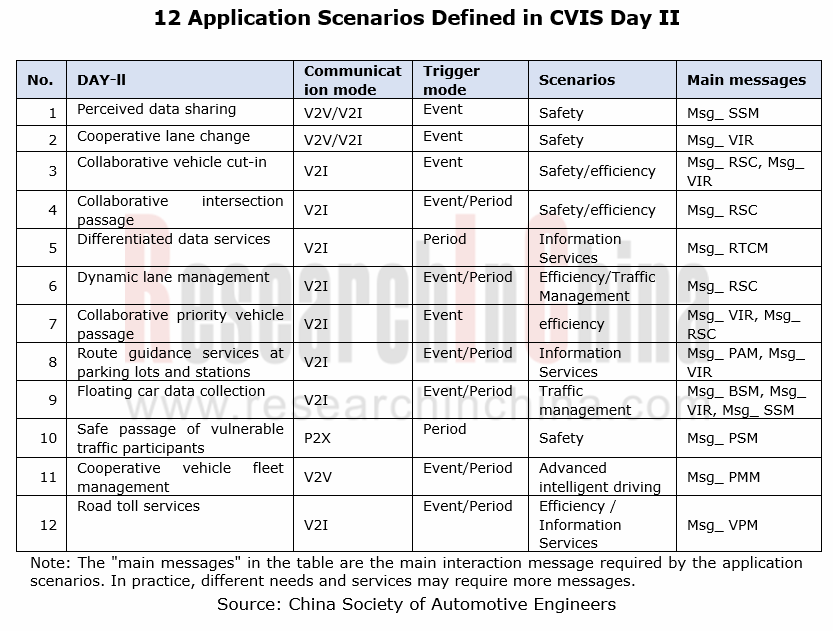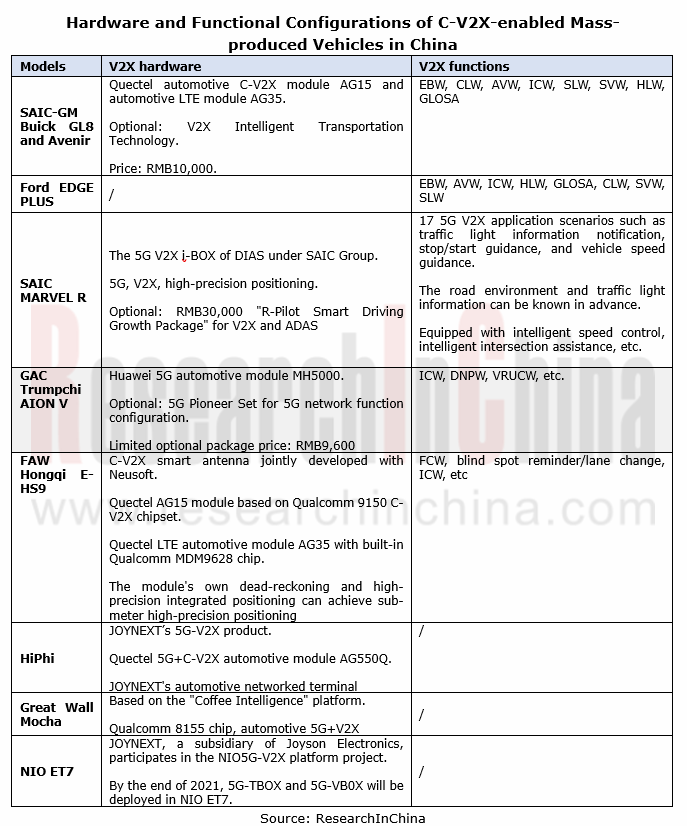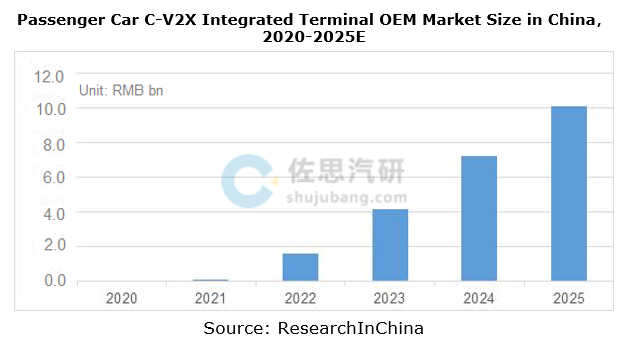V2X (Vehicle to Everything) and CVIS (Cooperative Vehicle Infrastructure System) Industry Report, 2021
V2X and CVIS Industry Report: 5G V2X will be a Standard Configuration for Digital Cockpits
After months of debate, in November 2020, the US Federal Communications Commission (FCC) voted for allocation of 75MHz of the spectrum band (5.850-5.925GHz), which had previously been reserved for Dedicated Short-Range Communications (DSRC) services, to Wi-Fi and C-V2X uses, which means the US has given up DSRC and turned to C-V2X.
In 2021, China government has issued the 14th Five-Year Plan (2021-2025) for National Economic and Social Development and the Long-Range Objectives through the Year 2035, and the National Comprehensive Three-dimensional Transportation Network, indicating that in the 15 years to come, China should lead the world in intelligent connected vehicle (intelligent vehicle, autonomous driving, CVIS) by providing full coverage of spatio-temporal information service and transportation perception, and defining China’s “CVIS + autonomous driving” technology roadmap.
C-V2X technology is in the first phase of implementation, and OEMs tend to explore application scenarios.
In September 2020, the 5G Automotive Association (5GAA) worked out a C-V2X communication technology roadmap.

Based on the current 3GPP’s 5G technology release speed, global deployment of 5G technology, and automotive communication technology supply chain status, combining 5GAA’s prediction and the reality in China, we think the use of C-V2X technology will pass through the following three phases:
2020-2023:
Having become available to mass-produced vehicles, C-V2X now depends on 4G LTE-V2X(R14, R15)technology to offer basic safety functions: LTE-V2X enables higher traffic efficiency and assisted driving safety, and will support other functions such as electronic brake light, left turn assistance, automated valet parking (AVP) in a parking lot, and remote-controlled driving.
In some low- and medium-speed automated driving scenarios (ports, mining areas, parks, etc.), LTE-V2X (R15, composed of 4G core networks + 5G base stations) works for vehicle infrastructure cooperation.
2024-2026:
Based on NR V2X+5G Uu, achieve CVIS-enabled automated driving (R16-released in July 2020), R17-expected to freeze in mid-2022), with available functions including coordinated protection of vulnerable groups in traffic and cooperative automated driving on urban roads;
HD map data (static/semi-static and dynamic) and sensor data (camera, LiDAR, radar, etc.) can be broadcasted to nearby autonomous vehicles for assisted driving decision.
Beyond 2026:
5G NR V2X will be mature enough to be a standard configuration for highly automated vehicles. The combination of NR V2X and 5G eMBB allows for the sharing and collaboration of high-precision perception data between vehicles, and the collaborative interaction between vulnerable traffic participants. By 2029, it will enable collaborative traffic flow management and automated vehicle flow takeover on highways or at intersections.
In China’s case, the Cooperative Intelligent Transportation System, Vehicular Communication, Application Layer Specification and Data Exchange Standard (Day II), an association standard, started soliciting opinions in November 2020. Compared with the CVIS DAY I released in 2017, the CVIS Day II underlines the interactions between vehicles, infrastructures and pedestrians and makes the trend to “vehicle-infrastructure cooperation” technology clearer, which means more V2I scenarios will come out and roadside (edge end) capabilities will play a role.

Through the lens of the mass production of OEMs in China, the 17 typical use cases in the CVIS DAY I can already be seen in vehicles; for the typical Day II use cases, the formulation of recommended standards is underway, and development and commercialization is expected to be phased in in 2021.
For example, Ford China is testing “direct connection” mode-based V2I and V2V capabilities such as electronic emergency brake light (EEBL) and intersection movement assist (IMA), and will further integrate V2X with Co-Pilot 360 ADAS and push them to users over the air (OTA).

In future 5G V2X may be a standard configuration for digital cockpits
In the next several years, the stronger computing force of chips will come with much more rapid integration of digital cockpits and a disruption in conventional on-board units like T-BOX; smart cockpits that integrate with more functions including ADAS, V2X and cloud services will hold the trend. Qualcomm's third- and fourth- generation Snapdragon automotive digital cockpit platforms both combine C-V2X. In future, 5G V2X may be a standard configuration for digital cockpits.
V2X can fuse with on-board smart terminals like IVI system and T-BOX, as well as ADAS or autonomous driving platform. Tier1s and OEMs have been developing corresponding products. Specifically, C-V2X hardware products have the following forms:
- C-V2X+T-BOX on-board terminals can integrate with such technologies and products as 4G/5G module, C-V2X module, CAN controller and GNSS. PATEO’s 5G C-V2X T-BOX packs Huawei MH5000 module. PATEO has partnered with Huawei closely in communication modules since 2009, with their cooperation extending from Huawei MU203 module at first to 4G, 4.5G C-V2X and 5G C-V2X; at the 2020 C-V2X Cross-industry & Large-scale Pilot Plugfest, the fleet co-built by PATEO, Huawei and BAIC completed dozens of scenario demonstrations like V2I (vehicle to infrastructure) and V2V (vehicle to vehicle) and showed applications, for instance, AR navigation, ADAS and lane-level HD navigation map.
- The further integration of UWB / WIFI / Bluetooth keyless entry and other functional modules into all-in-one intelligent antennas already highly integrated with such as GNSS positioning module, 4G/5G and V2X may be taken into account. Honqqi E-HS9 launched in late 2020 carries the C-V2X intelligent antenna that is jointly developed with Neusoft.
- “ETC+T-BOX+C-V2X” all-in-one terminals. An example is China TransInfo Technology Co., Ltd. which integrates automotive-grade ETC and C-V2X PC5 modules into the existing passenger car 4G/5G T-Box platform to connect ETC and V2X to vehicle navigation system and ADAS.
- AR navigation and AR HUD technology will further enhance the fusion of ADAS, V2V and V2I communication technologies, becoming an important display interface for V2X. Mocha, a mass-produced model under Great Wall WEY, has carried Qualcomm 8155 cockpit chip, 5G+V2X and AR-HUD.
- Autonomous driving DCU that fuse with C-V2X can serve as redundant sensors for autonomous driving. Qualcomm Snapdragon Ride hardware stack incorporates planning, positioning (Qualcomm Vision Enhanced) and perception (camera, radar, LiDAR, sensor fusion, C-V2X). V2X software supports ITS protocol stacks subject to SAE and ETSI standards, as well as third-party ITS protocol stacks.
In general, most of the current models spawned by OEMs adopt the technical solutions integrated with V2X module and T-BOX. At present, 5G+LTE-V2X+WiFi+GNSS functions can be integrated into one module priced at RMB2,000 or so.
In future, the price will have a further drop to RMB1,000 to RMB1,500, and those based on R16/R17 5G NR will be a bit more expensive. Optimists predict that China’s passenger car C-V2X OEM terminal market will be worth more than RMB10 billion in 2025.

In addition, in an age of software-defined vehicles, Tier1s can provide OEMs with road scenario tests, middleware (ITS protocol stack) and application layer development services and charge them development and license fees, while the value of pure protocol stack providers will be highlighted.
Foreign protocol stack providers are led by Cohda Wireless, Commsignia, Savari, MARBEN and Veniam; in China, typical players are Baidu Apollo, Neusoft VeTalk, Nebula Link and iSmartWays.
Samsung Harman’s buyout of the V2X software provider Savari in March 2021 and its early investment in Autotalks enable Samsung to offer complete V2X TCU software and hardware solutions in an age of 5G. Samsung 5G V2X TCU is to be mounted on BMW iX SUV at the end of 2021.
In China, Nebula Link, an ITS software stack provider rolls out V2X stack software protocols for conventional Tier1s, for example, offering communication protocol stacks and upper application algorithm software to vehicle V2X products of JOYNEXT, a subsidiary of Joyson Electronics, which have been applied to the mass-produced model platform of one OEM in China.
In addition, V2X modules of Morningcore Technology Co., Ltd. under China Information and Communication Technology Group Co., Ltd. (CICT) integrate with CWAVE II, Nebula Link’s C-V2X national standards-compliant protocol stack. 2 million sets of CX7101N, a full-stack software and hardware integrated solution for mass-produced vehicles jointly introduced by Nebula Link and Morningcore Technology, are projected to be used in the next five years.
Autonomous Driving Domain Controller and Central Computing Unit (CCU) Industry Report, 2025
Research on Autonomous Driving Domain Controllers: Monthly Penetration Rate Exceeded 30% for the First Time, and 700T+ Ultrahigh-compute Domain Controller Products Are Rapidly Installed in Vehicles
L...
China Automotive Lighting and Ambient Lighting System Research Report, 2025
Automotive Lighting System Research: In 2025H1, Autonomous Driving System (ADS) Marker Lamps Saw an 11-Fold Year-on-Year Growth and the Installation Rate of Automotive LED Lighting Approached 90...
Ecological Domain and Automotive Hardware Expansion Research Report, 2025
ResearchInChina has released the Ecological Domain and Automotive Hardware Expansion Research Report, 2025, which delves into the application of various automotive extended hardware, supplier ecologic...
Automotive Seating Innovation Technology Trend Research Report, 2025
Automotive Seating Research: With Popularization of Comfort Functions, How to Properly "Stack Functions" for Seating?
This report studies the status quo of seating technologies and functions in aspe...
Research Report on Chinese Suppliers’ Overseas Layout of Intelligent Driving, 2025
Research on Overseas Layout of Intelligent Driving: There Are Multiple Challenges in Overseas Layout, and Light-Asset Cooperation with Foreign Suppliers Emerges as the Optimal Solution at Present
20...
High-Voltage Power Supply in New Energy Vehicle (BMS, BDU, Relay, Integrated Battery Box) Research Report, 2025
The high-voltage power supply system is a core component of new energy vehicles. The battery pack serves as the central energy source, with the capacity of power battery affecting the vehicle's range,...
Automotive Radio Frequency System-on-Chip (RF SoC) and Module Research Report, 2025
Automotive RF SoC Research: The Pace of Introducing "Nerve Endings" such as UWB, NTN Satellite Communication, NearLink, and WIFI into Intelligent Vehicles Quickens
RF SoC (Radio Frequency Syst...
Automotive Power Management ICs and Signal Chain Chips Industry Research Report, 2025
Analog chips are used to process continuous analog signals from the natural world, such as light, sound, electricity/magnetism, position/speed/acceleration, and temperature. They are mainly composed o...
Global and China Electronic Rearview Mirror Industry Report, 2025
Based on the installation location, electronic rearview mirrors can be divided into electronic interior rearview mirrors (i.e., streaming media rearview mirrors) and electronic exterior rearview mirro...
Intelligent Cockpit Tier 1 Supplier Research Report, 2025 (Chinese Companies)
Intelligent Cockpit Tier1 Suppliers Research: Emerging AI Cockpit Products Fuel Layout of Full-Scenario Cockpit Ecosystem
This report mainly analyzes the current layout, innovative products, and deve...
Next-generation Central and Zonal Communication Network Topology and Chip Industry Research Report, 2025
The automotive E/E architecture is evolving towards a "central computing + zonal control" architecture, where the central computing platform is responsible for high-computing-power tasks, and zonal co...
Vehicle-road-cloud Integration and C-V2X Industry Research Report, 2025
Vehicle-side C-V2X Application Scenarios: Transition from R16 to R17, Providing a Communication Base for High-level Autonomous Driving, with the C-V2X On-board Explosion Period Approaching
In 2024, t...
Intelligent Cockpit Patent Analysis Report, 2025
Patent Trend: Three Major Directions of Intelligent Cockpits in 2025
This report explores the development trends of cutting-edge intelligent cockpits from the perspective of patents. The research sco...
Smart Car Information Security (Cybersecurity and Data Security) Research Report, 2025
Research on Automotive Information Security: AI Fusion Intelligent Protection and Ecological Collaboration Ensure Cybersecurity and Data Security
At present, what are the security risks faced by inte...
New Energy Vehicle 800-1000V High-Voltage Architecture and Supply Chain Research Report, 2025
Research on 800-1000V Architecture: to be installed in over 7 million vehicles in 2030, marking the arrival of the era of full-domain high voltage and megawatt supercharging.
In 2025, the 800-1000V h...
Foreign Tier 1 ADAS Suppliers Industry Research Report 2025
Research on Overseas Tier 1 ADAS Suppliers: Three Paths for Foreign Enterprises to Transfer to NOA
Foreign Tier 1 ADAS suppliers are obviously lagging behind in the field of NOA.
In 2024, Aptiv (2.6...
VLA Large Model Applications in Automotive and Robotics Research Report, 2025
ResearchInChina releases "VLA Large Model Applications in Automotive and Robotics Research Report, 2025": The report summarizes and analyzes the technical origin, development stages, application cases...
OEMs’ Next-generation In-vehicle Infotainment (IVI) System Trends Report, 2025
ResearchInChina releases the "OEMs’ Next-generation In-vehicle Infotainment (IVI) System Trends Report, 2025", which sorts out iterative development context of mainstream automakers in terms of infota...